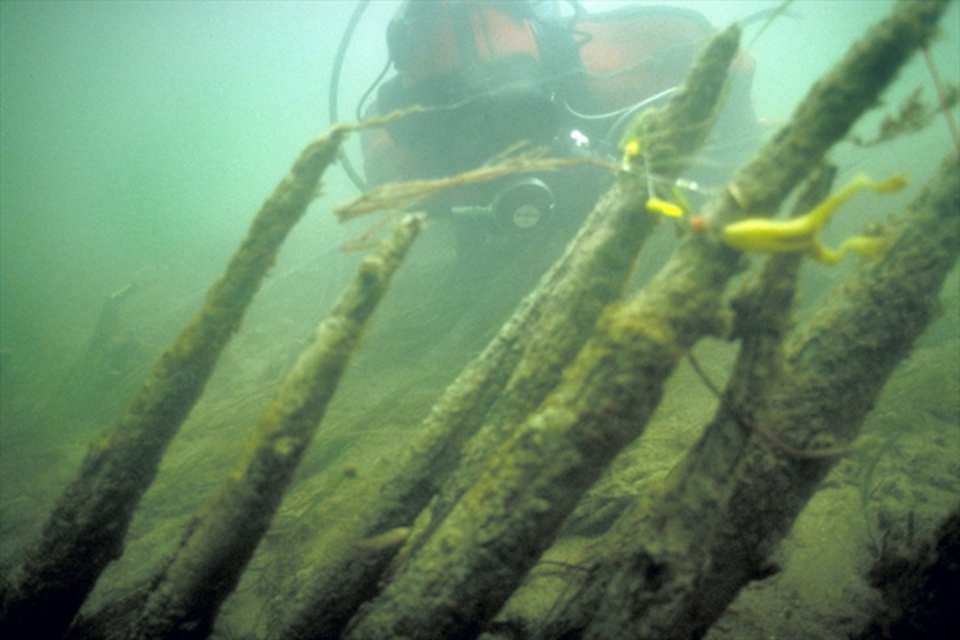There's is a place called the Atherley Narrows in northern Simcoe County where people have been fishing for thousands of years.
A long time ago, around the time of the pyramids, people observed that the fish would cross at this location from one lake, now named Simcoe, to another now named Lake Couchiching.
The fish spent summers and winters in the deep waters of Lake Simcoe, but in the spring would spawn in the shallow waters of Couchiching.
Over time, a technology was developed to trap these fish in areas where they could be speared. This was accomplished by driving stakes into the lake bottom. These weirs, also known as fences, would force the fish into areas where awaiting fishermen could spear them. A similar practice was also employed on land with larger mammals like deer.
Fish weirs can also be formed using rocks to force fish to one area where they can be netted or speared.
There are possibilities, even probabilities, that other local rivers and lakes have fish weirs, or had fish weirs used under their waters, but perhaps we just did not recognize them as such.
The distinction of the Atherley Narrows (Mnjikaning) location is that it was used for a number of years, by many people across the continent, and due to low current (at least by my conjecture) meant that the artifacts of that location are still in situ.
We often go to modern maps and culture to try and understand ancient movements of people. And thus we fall short. Coldwater and the end of what we know as Severn Sound was an important part of the native culture, but is overlooked today.
It was a hub for the people of Ontario at the time.
The fish weirs attracted people from all areas. Its unique features of shallow Lake Couchiching and deep Lake Simcoe meant a migration twice a year of fish into and out of the shallow lake for spawning. This meant many people knew how to get to "the narrows," then known as Tkaronto or where trees stand in water.
Coldwater also held a position where Georgian Bay was at hand, and the upper Great Lakes. This allowed those who wished to trade with those living in the area to descend easily.
The Severn River was also close, and a portage route to the Grand River could bring people in from the south. Heading north was the Muskoka River and traders there.
So Coldwater had long been a hub of trade, but when the fur trade came to prominence, it only increased the activity.
In a land deemed uncivilized, this was a place of peace and many different people met here for the spring fishing season.
When travelling across Lake Ontario, early explorers got to an area where Yonge Street now lies. The native peoples would point up the Carrying Place trail (now known as Yonge Street) to indicate that Tkaronto (place of trees in the water) was three days up that trail.
Of course, it wasn't so simple. You would go north on Carrying Place Trail to Lake Simcoe then cross in canoes.
As linguist John Steckley notes: “The name comes from the Mohawk 'tkaronto' 'trees or poles in water', and it links with those 4,000-plus-year-old cedar poles in the Atherley Narrows. There is a Wyandot name Karontu, meaning the same thing, that is a Large Turtle clan man's name.
How long weirs in this area have been used is unknown. The oldest ones they have found and dated are from the time of the pyramids, or slightly before the time of Christ.
However, it is unlikely we have the oldest sample available, as some weirs may not have any remaining remnants.
When Samuel de Champlain travelled through the area in the 1600s, he was brought to the fish weirs by the Wendat people. They were living in the area and were the caretakers at the time.
Later, around 1830, the Chippewa were granted land there, only to be coerced into moving to nearby Rama and Beausoleil Island. The Chippewa remain the caretakers today.
However, it would not be proper to suggest that the Chippewa replaced the Wendat as they always lived nearby in the time of the Wendat.
In fact, to be accurate, the name Huron, given to the people of the area by the French, would include both Wendat and Anishinaabe peoples. As it was a blanket name for all peoples in the area.
Today, there is a plaque and park dedicated to the Mnjikaning Fish Weirs National Historic Site. There is also a group called the Mnjikaning fish circle who have been pushing for an interpretive centre.
Area historian Art Duval explores the region's rich history through his website Pipesmoke of the Past.



